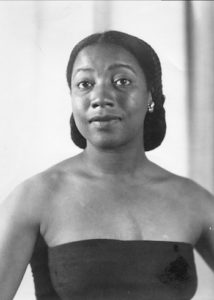
Thelma Streat
*Thelma Streat was born on this date in 1912. She was a Black Artist, Dancer, Educator, and Folklorist.
Thelma Johnson was born in Yakima, Washington, the daughter of James and Gertrude Johnson. She grew up in Boise, Idaho, Pendleton, Oregon, and Portland, Oregon, and graduated from Washington High School, Portland. She started painting at nine years of age, and at 17, she gained national recognition when her painting “A Priest” won an honorable mention at the Harmon Foundation exhibit in New York City in 1929.
In 1935, she married Romaine Streat in Portland. In 1939, she worked with Mexican muralist Diego Rivera on his Pan-American Unity mural in San Francisco. She also headed the Children’s Education Project, which introduced American kids to the contributions of Blacks through a series of colorful murals.
Streat gained prominence in the 1940s for her art, performance, and work to foster intercultural understanding and appreciation. Streat became the first African American woman to have a painting exhibited at the Museum of Modern Art (MOMA) in New York in 1942. By 1947, she was one of only four Black abstract painters who had solo shows in New York. The other three were Romare Bearden, Rose Piper, and Norman Lewis. In 1949, she became the first American woman to have a television program in France. In addition, Streat traveled to Haiti, Mexico, and Canada to study indigenous people's traditional dance and culture.
She realized that prejudice and bigotry are learned and usually during childhood. So, throughout the 1940s and 50s, she tirelessly performed dances, songs, and folk tales from many cultures to thousands of youngsters across Europe, Canada, Mexico, and the United States. This effort was to introduce them to the beauty and value of all cultures. In 1950, Streat performed a dance recital at Buckingham Palace for the King and Queen of England. Her talents included painting, textile design, book illustration, interpretive and ethnic dance, singing, folklore, teaching art, and multi-culturalism.
Her paintings have appeared in exhibits at such prestigious museums and galleries as the Museum of Modern Art (MoMA), the American Contemporary Art Gallery, the Honolulu Academy of Art, the San Francisco Museum of Art, (Vincent Price’s) The Little Gallery, the DeYoung Memorial Museum, City of Paris Gallery, the Art Institute of Chicago, the Albany Institute of the History of Art, the Kenkeleba Gallery and the Portland Art Museum.
Her most famous painting, “Rabbit Man,” is part of the MoMA’s permanent collection. Many world personalities have owned Streat’s work, including singer Roland Hayes, artist Diego Rivera, actress Fanny Brice, dancer Katherine Dunham, and actress Paulette Goddard. Streat founded Children’s City near Honolulu with her second husband, John Edgar Kline, to introduce children to art and the value of cultural diversity.
Many of Streat’s portraits presented men, women, girls, and boys of every color, age, shape, and size with dignity. Her work was sometimes controversial. In 1947 the Los Angeles Times reported that Streat was threatened by the Ku Klux Klan for her painting called “Death of a Negro Sailor,” portraying a Black sailor dying after risking his life abroad to protect the democratic rights he was denied at home.
Streat responded that a program showing black tribulations and contributions to the nation’s wealth was needed. Soon after, she initiated a visual education program called “The Negro in History.” Through a series of murals depicting the contributions of people of African descent, panels showed blacks in industry, agriculture, medicine, science, meatpacking, and transportation. There was even a panel on the contributions of Black women.
As a pioneer in modern African American art, her work influenced and was influenced by Jacob Lawrence, Sargent Johnson, Romare Bearden, William H. Johnson, and the other artistic leaders of her time. Her ability to integrate dance, song, and folklore from various cultures into a presentation package and utilize it to educate and inspire an appreciation across ethnic lines was revolutionary for her time. Thelma Streat died in May 1959 in Los Angeles, California.
The St. James Guide to Black Artist
Edited by Thomas Riggs
Copyright 1997
Detroit, MI
ISBN 1-55862-220-9